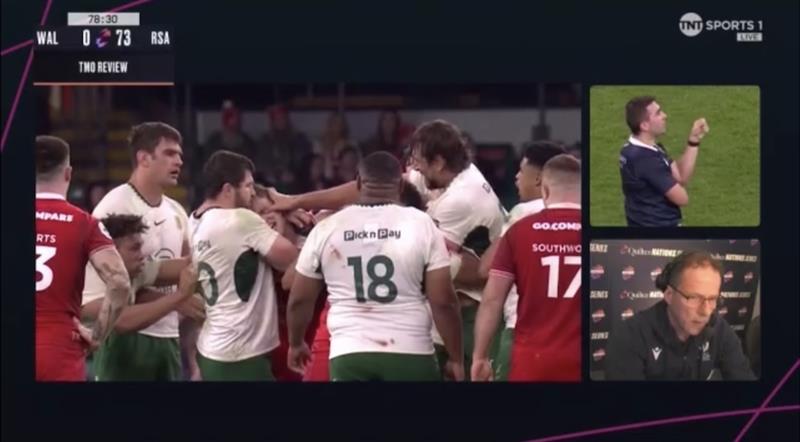Rugby rules explained: they’re not just a conspiracy cooked up by referees to blow their whistles every thirty seconds — there’s actually a system beneath the chaos.
(Blindsided Rugby Man edition – your smart, cheeky, pub-side guide to not sounding lost when the ref whistles for the fifth time in two minutes.)
What are the Rules of Rugby?
Fifteen humans per side, one lumpy ball, 100 metres of real estate, and 80 minutes to bully, dance, and think your way over a white line. Rugby union is a territory game wrapped in a wrestling match, seasoned with chess. You don’t just “have the ball”; you fight for the right to have the ball, and the laws reward teams that stay disciplined, work in pods, and know when to kick the thing into the sky like they’re launching a weather balloon.
Basic Rugby Rules (aka, the “so you don’t get chirped” bit)
- Duration: 80 minutes, split into two 40-minute halves. The clock stops for injuries and set-piece faff; the half ends only when the ball next goes dead. Extra time (should a match get that terrifyingly far) is 10 minutes each way.
- The Field: Up to 100m long goal-line to goal-line, 70m wide. The 22-metre lines and 10-metre lines matter for kick rules. In-goal areas sit behind each goal-line; that’s the land of tries, drama, and “Did he ground it?” slow-mo.
- The Ball: Egg-shaped so it travels like a drunk UFO in the wind. Passes cannot be thrown forward. If the ball is lost forward or thrown forward, it’s a knock-on/forward pass → scrum to the other side.
- Contact: You may tackle only the ball-carrier, below the neck, with arms. No shoulder charges, no tip tackles, no lost teeth on purpose.
- Officials: One referee and two assistant refs (plus a TMO in many competitions). The whistle is law. Argue badly and you’ll donate 50 metres and your dignity.
The Points (how you actually win)
- Try – 5 points: Ground the ball with downward pressure on or over the goal-line (in the in-goal area).
- Conversion – 2 points: After a try, a place-kick or drop-kick from a spot in line with where the try was scored.
- Penalty Goal – 3 points: Awarded for significant infringements. Kick it over from the mark or the team may choose touch for territory.
- Drop Goal – 3 points: Open play, ball dropped and kicked on the bounce through the posts. Polarises crowds; wins tournaments.
Bonus points? Many comps award a bonus point for scoring 4+ tries or losing by 7 or fewer. That’s competition-specific, not a universal law of the game.
Rugby Game Rules: How the Game Flows (and where the whistle usually interrupts)
Kicking & Restarts
- Kick-off: Drop-kick from halfway; must travel 10m.
- 22m Drop-out vs Goal-line Drop-out:
- Goal-line drop-out when the attacking team is held up over the line, knocks on in-goal, or kicks it in and the defenders make it dead.
- 22m drop-out when the defending team put the ball into their own in-goal and make it dead (e.g., carried back, then grounded).
- The Mark: Inside your 22, catch a kick cleanly and shout “Mark!” You get a free-kick.
- 50:22: If you kick from your own half and it bounces into touch inside the opposition 22, your team throws into the lineout. Tactical gold for teams who like stretching edge defenders.
Advantage
Ref sees an infringement? He may signal advantage. If the non-offending team gains something meaningful (territory/possession chance), play on. If not, we go back to the original penalty/scrum. Savvy teams use advantage as a free swing at the fences.

The Set Pieces (where packs earn their steak)
The Scrum (8 v 8)
- Why: For knock-ons, forward passes, or accidental offsides.
- How: Three rows bind (props, hooker; locks; loose forwards). The scrum-half feeds; hookers hook; the pack pushes square.
- Offside lines: Backs must stay five metres behind the hindmost foot until the ball is out.
- Penalties you’ll hear: Early push, collapse, angling in, not straight feed, standing up, wheeling intentionally.
The Lineout (chorus line, but with lifting)
- Why: When the ball goes into touch (out of play at the sideline).
- How: Hooker throws straight down the middle between two lines of jumpers. Lifters hoist, jumpers compete.
- Quick lineout: Same ball, same thrower, no time-wasting, and only if the ball didn’t touch anyone else. Risky but spicy.
The Breakdown: Ruck & Maul (where games are won, lost, and slowed)
The Tackle
- Legal tackle: Wrap arms, contact below the neck (and in many comps, emphasis is on lower tackle height for safety).
- The moment he hits the deck:
- Ball-carrier must release or pass.
- Tackler must release the player, roll away, and get back onside.
- Arrive through the gate (from your side, behind the tackled player).
- No hands in the ruck: Once a ruck forms (ball on the ground, players from both teams bound over it), you can’t use hands. You must win it with body position and drive.
The Ruck
- Formed when at least one player from each team is in physical contact over the ball on the ground.
- Offside line: The hindmost foot of the last player in the ruck. Stand beyond it or bring your lungs; the ref will move you back.
- Jackal: A defender who legally supports their weight, shows a clear lift on the ball before the ruck forms (or immediately at the ruck with legal entry) can win a turnover penalty. Timing and technique is everything.
The Maul
- Formed when the ball-carrier is held up by opponents and supported by a team-mate, all on their feet.
- Attacking mauls off lineout throws are a battering ram. Collapsing a maul is illegal. Pulling down is different from sacking (legal before the maul fully sets under certain conditions; watch competition directives).
Offside 101 (because it gets everyone)
- General play: If your team kicks, any team-mate in front of the kicker is offside until put onside by a retreat/re-engagement rule (e.g., they come behind the kicker or an onside team-mate runs them onside).
- Rucks/Mauls: Stay behind the hindmost foot.
- Scrums: Backs stay 5m back; scrum-halves can’t block or dive through like gremlins.
- Lineouts: Non-participants must be 10m back until the lineout ends (usually when the ball leaves the lineout or the maul moves beyond it).
Penalties, Free-kicks & Cards
- Free-kick (FK): Technical stuff (e.g., early engagement at the scrum, time wasting). You can’t kick direct to posts from an FK.
- Penalty (PK): More serious: offside, high tackle, not rolling away, side entry, collapsing a maul, deliberate knock-on. Options: kick at goal, kick to touch (your lineout), tap and go, or scrum.
- Yellow Card: 10 minutes in the bin. Your team plays with 14. Discipline isn’t optional; it’s arithmetic.
- Red Card: Off you go for good. In some comps a “bunker review” may upgrade a yellow to a red after further TMO review; once red, you’re done for the match.
- March 10 (or 10 metres): Mouth off, or slow the ball, and the ref walks the mark forward. Keep chatting and you’ll gift a kickable angle.
Positions: Who’s Who in the 1–15 Pageant
The Tight Five (1–5): The Engine Room
- Loosehead Prop (1): Stabilises the scrum on the left, chews up tightheads for breakfast. Short carries, low body height, many neck exercises.
- Hooker (2): Throws into lineouts, hooks the ball at scrum time, tackles like a street sweeper.
- Tighthead Prop (3): The anchor on the right. If your tighthead creaks, your whole platform creaks.
4–5. Locks (4 & 5): Tall timber. Primary jumpers, maul pilots, and tonnage providers in contact.
The Loose Forwards (6–8): The Back-Row Hybrids
- Blindside Flanker (6): Enforcer on the short side. Smashes carriers, owns the collision.
- Openside Flanker (7): Fetcher, breakdown jackal, link player. If the ball hits the deck, 7’s already there.
- Number Eight (8): Back of the scrum boss. Carries off the base, links with 9/10, often the team’s momentum thermostat.
The Half-backs (9–10): Brains and Boot
- Scrum-half (9): Distributor, box-kicker, ref whisperer. Dictates tempo at ruck base.
- Fly-half (10): Quarterback with a calculator. Calls patterns, chooses kick/pass/run, and must kick their goals under pressure.
The Midfield (12–13): Route Planners and Door Locks
- Inside Centre (12): Crash-ball option or second playmaker. Defends the messy channel next to 10.
- Outside Centre (13): Defensive organiser out wide, line-breaker, king of the out-to-in line.
The Back Three (11, 14, 15): Finishers & Firefighters
11 & 14. Wings: Fast finishers, aerial contestants, touchline policemen. Must chase kicks like rent is due.
15. Fullback: Sweeper, counter-attacker, last line of sanity. Needs a cannon of a boot and a calm head under high bombs.
Replacements (16–23): Impact players. Most comps allow eight subs, including a reserve front row for safety. Tactical and injury substitutions shape the last quarter.
Common Infringements (and how not to give away free points)
- High Tackle: Anything around the head/neck. Keep it low, shoulder down, arms wrapping.
- Side Entry at Ruck: Entering from the side rather than “through the gate.”
- Not Releasing: Ball-carrier fails to let go after being tackled; or tackler refuses to release/roll away.
- Off Feet: Flopping over the ruck like a beached seal. Must support your own weight.
- Deliberate Knock-on: Slapping at a pass without a realistic catch attempt. Usually a penalty, sometimes a card.
- Scrum Angling/Collapse: Props, behave. Straight and square or jog back 10.
- Lineout Not Straight: Hooker’s worst nightmare; throws must split the gap.
Kicking: The Unsung Art
- Box Kick: From 9, high and short, invites a contest.
- Clearance Kick: Hammer it to touch to escape pressure (especially from your own 22).
- Chip & Grubber: Over or through a rush defense when hands aren’t enough.
- Cross-Kick: 10 to wing; a winger’s Christmas present.
- Drop Kick: Required for kick-offs, restarts, and of course drop goals.
- Place Kick: For penalties and conversions — usually your 10 or 15’s side hustle.
Tactics in One Pint
- Territory First: Win the kicking battle; play rugby in their half.
- Set-Piece Platform: A stable scrum and accurate lineout make your backs look like geniuses.
- Breakdown Discipline: One silly penalty flips field position 40 metres the wrong way.
- Tempo Control: Slow it when you’re ahead; add speed when lumberjacks are tiring.
- Edges & In-Behind: Attack narrow to draw defenders, then blast the edges or drop a kick in behind.
- Multi-Phase Patience: It’s not Madden. Sometimes it takes 10+ phases to pull a defense out of shape.
Ref Signals You’ll See (and Pretend You Always Knew)
- Arm horizontal, pointing: Scrum to that side.
- Arm up, straight: Penalty to that side.
- Two fingers to lips then pointing down: Mark.
- Both arms extended and “play on”: Advantage.
- Rectangle sign in the air: TMO check.
- Hand tapping shoulder/head area: High tackle foul play zone. You know what’s coming.
Safety & Tackle Height (the modern reality)
Player welfare rules keep tightening. Expect:
- Stricter sanctions on high contact and head-on-head collisions.
- Emphasis on lower tackle height and proper wrap.
- Clear steps for head injury assessment (HIA).
Bottom line: technique > hero shots. Hit low, hit safe, live to hit again.
Subtleties That Win Matches
- Counter-Ruck: If the carrier isolates, blast over legally and steal momentum.
- Pillars & Posts: Guard the ruck fringes; lazy spacing leaks metres.
- Decoy Lines: Make defenders choose; even fake runs create real space.
- Numbers Game: Count the short side. Three attackers on two defenders? Play there now, not after a committee meeting.
- Kick Pressure: Contestable kicks are only good if the chase is hungry and straight.
- Game Management: Up 6 with 5 to play? Kick to corners, squeeze penalties, drain the clock.
Quick FAQ (for your WhatsApp group arguments)
Q: Forward pass vs knock-on — difference?
A forward pass travels forward from the hands. A knock-on is losing control forward (off hand or arm). Both → scrum to opposition.
Q: Can you rip the ball in a tackle?
Yes, if you’re a legal tackler and it’s before a ruck forms. Once a ruck’s formed: no hands.
Q: What’s “held up”?
Attacker is taken over the line but doesn’t ground the ball. Goal-line drop-out to defenders.
Q: Can you kick the ball out on the full from outside your 22 and still keep the throw?
No. If you kick it out on the full from outside your 22 → lineout to the opposition where it crossed the line. From inside your 22, you may kick directly to touch and the lineout is where it went out (your throw if you kicked it there from a penalty).
Q: Why are some penalties quick taps?
To catch a lazy defense before it sets. It’s legal as long as it’s from the mark and the ball is properly tapped.
Q: Are all yellow cards 10 minutes?
Yes, standard sin-bin is 10 minutes off the field. In some comps, a “bunker” review can upgrade a yellow to a red after further analysis.
Rugby Rules Glossary
- Advantage: Free play after an infringement to see if you gain benefit.
- Bind: Legal grip in scrum/maul/ruck; no bind = penalty magnet.
- Breakdown: The tackle/ruck area where possession is contested.
- Counter-attack: Running back kicks with broken-field chaos.
- Dive pass: Quick, flat pass from 9 off the deck.
- Drop Goal: 3-pointer from open play via drop-kick.
- Gate: Legal entry line behind the tackled player’s body.
- Grubber: Low, bouncing kick along the ground.
- Jackal: Stealing the ball at the breakdown.
- Line Speed: How fast defenders advance; too quick, get chipped; too slow, get stepped.
- Maul: Ball-carrier held up with team-mate support, on feet, moving.
- Open/Blind Side: Open = more space; blind = short side of ruck/scrum.
- Phases: Consecutive rucks as play continues.
- Pillars/Posts: First defenders next to the ruck.
- Ruck: Ball on ground with players from both teams bound over it.
- Scrum-half (9): Link between forwards and backs; ruck boss.
- Turnover: Stealing possession legally (breakdown, touch, knock-on forced).
- Up-and-Under: High contestable kick (also “Garryowen”).
Mini Cheat Sheet (print this, laminate it, be that guy)
- Scoreboard priorities: Try (5) > Convert (2) > Pen (3) > Drop (3).
- Don’t give away penalties in your 40: they become 30–50 metres and three points.
- At the ruck: Enter through the gate, stay on feet, release, then jackal.
- Set-piece is platform: Lineout accuracy and scrum parity = launchpad.
- Kick smart: Find grass, not throats. Chase like you mean it.
- Discipline: Yellow cards lose matches. Shut the mouths, fix the feet.
Final Whistle
If rugby looks chaotic, it’s structured chaos. The laws reward teams that:
- Win collisions legally,
- Control territory with the boot,
- Execute set-piece, and
- Stay disciplined when lungs are burning.
Now you’ve got the language and the logic. Next time someone groans about a “soft penalty at the breakdown,” you can gently remind them that side entry is a lifestyle choice — and a three-point donation.
Go forth and be the most informed loudmouth at the braai.




